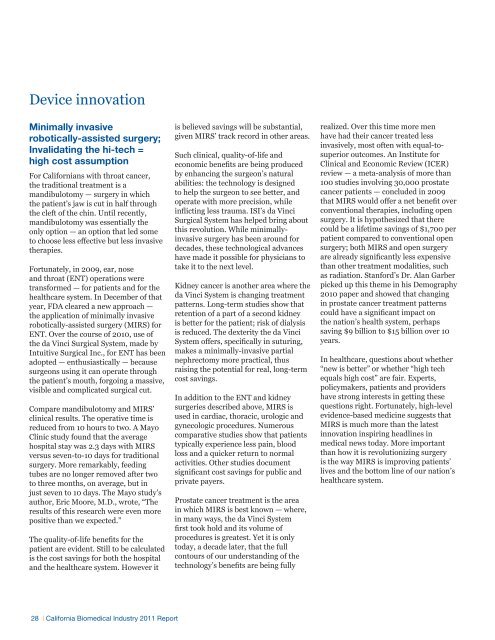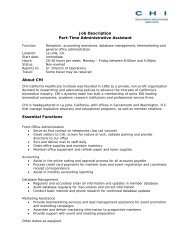California Biomedical Industry - California Healthcare Institute
California Biomedical Industry - California Healthcare Institute
California Biomedical Industry - California Healthcare Institute
Create successful ePaper yourself
Turn your PDF publications into a flip-book with our unique Google optimized e-Paper software.
Device innovationMinimally invasiverobotically-assisted surgery;Invalidating the hi-tech =high cost assumptionFor <strong>California</strong>ns with throat cancer,the traditional treatment is amandibulotomy — surgery in whichthe patient’s jaw is cut in half throughthe cleft of the chin. Until recently,mandibulotomy was essentially theonly option — an option that led someto choose less effective but less invasivetherapies.Fortunately, in 2009, ear, noseand throat (ENT) operations weretransformed — for patients and for thehealthcare system. In December of thatyear, FDA cleared a new approach —the application of minimally invasiverobotically-assisted surgery (MIRS) forENT. Over the course of 2010, use ofthe da Vinci Surgical System, made byIntuitive Surgical Inc., for ENT has beenadopted — enthusiastically — becausesurgeons using it can operate throughthe patient’s mouth, forgoing a massive,visible and complicated surgical cut.Compare mandibulotomy and MIRS’clinical results. The operative time isreduced from 10 hours to two. A MayoClinic study found that the averagehospital stay was 2.3 days with MIRSversus seven-to-10 days for traditionalsurgery. More remarkably, feedingtubes are no longer removed after twoto three months, on average, but injust seven to 10 days. The Mayo study’sauthor, Eric Moore, M.D., wrote, “Theresults of this research were even morepositive than we expected.”The quality-of-life benefits for thepatient are evident. Still to be calculatedis the cost savings for both the hospitaland the healthcare system. However itis believed savings will be substantial,given MIRS’ track record in other areas.Such clinical, quality-of-life andeconomic benefits are being producedby enhancing the surgeon’s naturalabilities: the technology is designedto help the surgeon to see better, andoperate with more precision, whileinflicting less trauma. ISI’s da VinciSurgical System has helped bring aboutthis revolution. While minimallyinvasivesurgery has been around fordecades, these technological advanceshave made it possible for physicians totake it to the next level.Kidney cancer is another area where theda Vinci System is changing treatmentpatterns. Long-term studies show thatretention of a part of a second kidneyis better for the patient; risk of dialysisis reduced. The dexterity the da VinciSystem offers, specifically in suturing,makes a minimally-invasive partialnephrectomy more practical, thusraising the potential for real, long-termcost savings.In addition to the ENT and kidneysurgeries described above, MIRS isused in cardiac, thoracic, urologic andgynecologic procedures. Numerouscomparative studies show that patientstypically experience less pain, bloodloss and a quicker return to normalactivities. Other studies documentsignificant cost savings for public andprivate payers.Prostate cancer treatment is the areain which MIRS is best known — where,in many ways, the da Vinci Systemfirst took hold and its volume ofprocedures is greatest. Yet it is onlytoday, a decade later, that the fullcontours of our understanding of thetechnology’s benefits are being fullyrealized. Over this time more menhave had their cancer treated lessinvasively, most often with equal-tosuperioroutcomes. An <strong>Institute</strong> forClinical and Economic Review (ICER)review — a meta-analysis of more than100 studies involving 30,000 prostatecancer patients — concluded in 2009that MIRS would offer a net benefit overconventional therapies, including opensurgery. It is hypothesized that therecould be a lifetime savings of $1,700 perpatient compared to conventional opensurgery; both MIRS and open surgeryare already significantly less expensivethan other treatment modalities, suchas radiation. Stanford’s Dr. Alan Garberpicked up this theme in his Demography2010 paper and showed that changingin prostate cancer treatment patternscould have a significant impact onthe nation’s health system, perhapssaving $9 billion to $15 billion over 10years.In healthcare, questions about whether“new is better” or whether “high techequals high cost” are fair. Experts,policymakers, patients and providershave strong interests in getting thesequestions right. Fortunately, high-levelevidence-based medicine suggests thatMIRS is much more than the latestinnovation inspiring headlines inmedical news today. More importantthan how it is revolutionizing surgeryis the way MIRS is improving patients’lives and the bottom line of our nation’shealthcare system.28 | <strong>California</strong> <strong>Biomedical</strong> <strong>Industry</strong> 2011 Report






